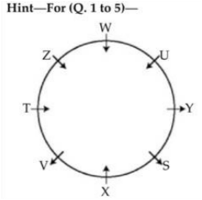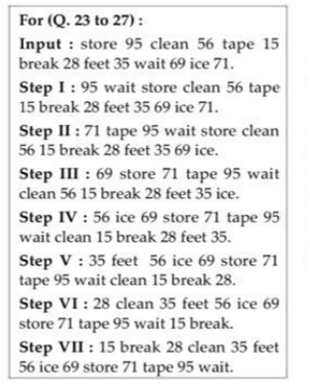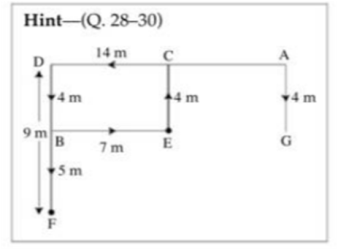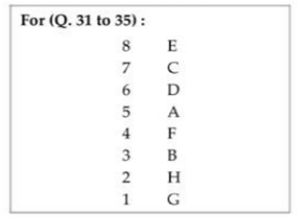
National Insurance Company Administrative Officers Examination Held on 4-4-2015
Reasoning
Directions-(Q. 1-5) Study the information carefully and answer the questions-
S, T, U, V, W, X, Y and Z are sitting around a circular area at equal distance between each other, but not necessarily in the same order. .Some of the people are facing the centre while some face outside. (i.e., in a direction opposite tot the centre.)
Note- Facing the same direction means if one faces the centre then the other also faces the centre and vice-versa. Facing opposite direction means if one person faces the centre then the other faces outside and vice-versa.
U sits third to the right of X. X faces the centre. Only three people sit between U and V. Z sits second to the right of V. W sits third to the left of S. S is an immediate neighbour of X. T sits second to the right of W. T is not an immediate neighbour of U. Immediate neighbours of T face opposite directions (i.e., if one neighbur faces the centre other faces outside and vice-versa.). U sits to the immediate left of Y. U and S face opposite directions T faces the same direction as W.

1. Who sits exactly between W and T, when counted from the right of W?
(A) Y
(B) Z
(C) V
(D) X
(E) S
2. Four of the following five are alike in a certain way based on the given seating arrangement and so form a group. Which is the one that does not belong to that group?
(A) Y
(B) W
(C) X
(D) U
(E) Z
3. What is X’s position with respect to Z?
(A) Third to the right
(B) Third to the left
(C) Immediate right
(D) Second to the left
(E) Immediate left
4. Who sits second to the left of Y ?
(A) T
(B) W
(C) S
(D) Z
(E) X
5. How many people in the given arrangement face outside ?
(A) Three
(B) One
(C) Two
(D) Five
(E) Four
Directions- (Q. 6 and 7) Study the given information and answer the given questions-
Following are few observations of a year-long study on mediation conducted on 300 people in the age group of 30-50 years-
(a) A specific form of mediation is a good way to increase creativity even in middle-aged people.
(b) Meditating regularly for even 15-20 minutes leads to 40-55% reduction in symptoms of stress and depression.
(c) Another form of meditation helps reduce cholesterol level, which further helps to maintain normal blood pressure.
6. Which of the following can be inferred from the given passage ?
(A) Meditation is more effective than anti-depresents
(B) There are than one types of meditation
(C) Cholesterol level can b e controlled only through meditation
(D) Meditation, to be fruitful, is to be done for a particular time only, i.e., meditating less than or more than the standard time is harmful
(E) Mediation is not helpful for anything other than improving one’s creativity
7. Which of the following cannot be a finding of the given study on meditation ?
(A) Regular meditation leads to a considerable increase in energy levels of people, particularly of those in the age group of 35-45 years
(B) Meditation improves the body metabolism, which is largely affected b y the cholesterol level in the body
(C) 106 at-risk adolescent in high schools reduced their levels of stress, anxiety and hyperactivity when practicing the Transcendental Meditation technique for two months at school
(D) As a result of low stress level, insomnia was reduced by 42% in people who practiced meditation for three weeks
(E) 128 people in professions like designing, writing or journalism performed better when they practiced regular meditation
Directions- (Q. 8-17) In this question, relationship between different elements is shown in the statements. The statements are followed by conclusions. Study the conclusions based on the given statement and select the appropriate answer.
8. Statements :
L < M < N; M = O > P < Q; R > Q
Conclusions : I. L < P
II. P < N
(A) Neither conclusion I nor II is true
(B) Either conclusion I or II is true
(C) Only conclusion II is true
(D) Both conclusion I and II are true
(E) Only conclusion I is true
9. Statements :
W < X < Y = Z < A; B < C = W
Conclusions : I. C < A
II. B > Z
(A) Neither conclusion I nor II is true
(B) Either conclusion I or II is true
(C) Only conclusion II is true
(D) Both conclusion I and II are true
(E) Only conclusion I is true
10. Statements :
L < M < N; M = O > P < Q; R > Q
Conclusions : I. Q < N
II. P < R
(A) Neither conclusion I nor II is true
(B) Either conclusion I or II is true
(C) Only conclusion II is true
(D) Both conclusion I and II are true
(E) Only conclusion I is true
11. Statements :
D = E > F > G < H ; G < J < K
Conclusions : I. H < D
II. K > H
(A) Neither conclusion I nor II is true
(B) Either conclusion I or II is true
(C) Only conclusion II is true
(D) Both conclusion I and II are true
(E) Only conclusion I is true
12. Statements :
S < T = U < V; X = W < S
Conclusions : I. X < V
II. X = V
(A) Neither conclusion I nor II is true
(B) Either conclusion I or II is true
(C) Only conclusion II is true
(D) Both conclusion I and II are true
(E) Only conclusion I is true
13. Statements : Some tents are buildings. some buildings are chairs. Some chairs are windows.
Conclusions :
I. Some windows are buildings.
II. Some windows are tents.
(A) Neither conclusion I nor II is true
(B) Either conclusion I or II is true
(C) Only conclusion II is true
(D) Both conclusion I and II are true
(E) Only conclusion I is true
14. Statements : All cups are benches. Some benches are drums. All drums are kites.
Conclusions:
I. Some kites are cups.
II. Some drums are cups.
(A) Neither conclusion I nor II is true
(B) Either conclusion I or II is true
(C) Only conclusion II is true
(D) Both conclusion I and II are true
(E) Only conclusion I is true
15. Statements : All silver are gold. All aluminium are gold. Some silver aluminium.
Conclusions :
I. Some gold is both silver and aluminium.
II. All gold can be aluminium.
(A) Neither conclusion I nor II is true
(B) Either conclusion I or II is true
(C) Only conclusion II is true
(D) Both conclusion I and II are true
(E) Only conclusion I is true
16. Statements : All rings are necklaces. All those necklaces which are not rings are earrings. No earring is a bracelet.
Conclusions :
I. Some bracelets are necklaces.
II. No ring is a bracelet.
(A) Neither conclusion I nor II is true
(B) Either conclusion I or II is true
(C) Only conclusion II is true
(D) Both conclusion I and II are true
(E) Only conclusion I is true
17. Statements : All cheques are notes. All notes are tyres. All tyres are books. All books are rods.
Conclusions :
I. Some rods are notes
II. Some books are tyres.
(A) Neither conclusion I nor II is true
(B) Either conclusion I or II is true
(C) Only conclusion II is true
(D) Both conclusion I and II are true
(E) Only conclusion I is true
18. In which direction is Mahatmaji’s statue facing?
I. The statue is towards the northern end of the city.
II. The statue’s shadow falls towards east at 5 O’clock in the evening.
(A) The data in either in Statement I alone or statement II alone sufficient to answer the question
(B) The data in statement I alone are sufficient to answer their question, while the data in statement II alone are not sufficient to answer the question
(C) The data in both the statements I and II together are necessary to answer the question
(D) The data in both the statements I and II together are not sufficient to answer the question
(E) The data in statement II alone are sufficient to answer the question, while the data in statement I alone are not sufficient to answer the question
19. What is the total number of pupils in the final year class?
I. The number of boys in the final year class is twice as much as the number of girls in that class.
II. The sum of the ages of all the pupils in the class is 399 years and their average age is 19 years.
(A) The data in either in Statement I alone or statement II alone sufficient to answer the question
(B) The data in statement I alone are sufficient to answer their question, while the data in statement II alone are not sufficient to answer the question
(C) The data in both the statements I and II together are necessary to answer the question
(D) The data in both the statements I and II together are not sufficient to answer the question
(E) The data in statement II alone are sufficient to answer the question, while the data in statement I alone are not sufficient to answer the question
20. How many floors are there in the building (including the ground floor) ?
I. The area in which the building stands has a rule that no building can have more than six floors (including the ground floor).
II. Three families reside in the building. No two families live immediately above or below each other.
(A) The data in either in Statement I alone or statement II alone sufficient to answer the question
(B) The data in statement I alone are sufficient to answer their question, while the data in statement II alone are not sufficient to answer the question
(C) The data in both the statements I and II together are necessary to answer the question
(D) The data in both the statements I and II together are not sufficient to answer the question
(E) The data in statement II alone are sufficient to answer the question, while the data in statement I alone are not sufficient to answer the question
21. How many people read both Economic Times and Financial Express ?
I. Out of 500 readers, 200 read Financial Express, 220 read Economic Times and 50 read Indian Expresses.
II. Out of total 500 readers, 220 read Economic Times, 200 reads Financial Express and 50 read neither.
(A) The data in either in Statement I alone or statement II alone sufficient to answer the question
(B) The data in statement I alone are sufficient to answer their question, while the data in statement II alone are not sufficient to answer the question
(C) The data in both the statements I and II together are necessary to answer the question
(D) The data in both the statements I and II together are not sufficient to answer the question
(E) The data in statement II alone are sufficient to answer the question, while the data in statement I alone are not sufficient to answer the question
22. In which year did Ranjana complete her graduation ?
I. According to Ranjana’s father she graduated after March 1989 but before March 1993.
II. The brother of Ranjana remembers correctly that she did her graduation after March 1991 but before March 1994 and the year of her graduation was an even number.
(A) The data in either in Statement I alone or statement II alone sufficient to answer the question
(B) The data in statement I alone are sufficient to answer their question, while the data in statement II alone are not sufficient to answer the question
(C) The data in both the statements I and II together are necessary to answer the question
(D) The data in both the statements I and II together are not sufficient to answer the question
(E) The data in statement II alone are sufficient to answer the question, while the data in statement I alone are not sufficient to answer the question
Directions- (Q. 23-27) Study the following information carefully and answer the given questions-
A word and number arrangement machine when given an input line of words and numbers rearranges them following a particular rule in each step. The following is an illustration of input and rearrangement. (All the numbers are two digit numbers).
Input : tent 13 wheat 21 ask 63 steal 49 hand 54 vast 85.
Step I : 85 wheat tent 13 21 ask 63 steal 49 hand 54 vast
Step II : 63 vast 85 wheat tent 13 21 ask steal 49 hands 54
Step III : 54 tent 63 vast 85 wheat 13 21 ask steal 49 hand
Step IV : 49 steal 54 tent 63 vast 85 wheat 13 21 ask hand
Step V : 21 hand 49 steal 54 tent 63 vast 85 wheat 13 ask
Step VI : 13 ask 21 hand 49 steal 54 tent 63 vast 85 wheat
Step VII : is the last step of the above input, as the desired arrangement is obtained.
As per the rules followed in the given steps, find out in each of the following questions the appropriate step for the given input.
Input : Store 95 clean 56 tape 15 break 28 feet 35 wait 69 ice 71.

23. Which step number is the following output?
Output : 35 feet 56 Ice 69 store 71 tape 95 wait clean 15 break 28.
(A) Step V
(B) Step III
(C) Step VI
(D) Step IV
(E) There is no such step
24. Which number/word be at sixth position from the right in step IV ?
(A) 15
(B) wait
(C) clean
(D) 95
(E) 28
25. How many elements (words/numbers) are there between ‘feet’ and ‘15’ as they appear in the second last step of the output?
(A) Six
(B) Seven
(C) Five
(D) Eight
(E) Nine
26. Which of the following represents the position of ‘wait’ in the third step?
(A) Ninth from the left
(B) Sixth from the left
(C) Eight from the right
(D) Seventh from the right
(E) Tenth from the right
27. Which number/ word would be at seventh position from the left in the step VI ?
(A) ice
(B) store
(C) tape
(D) 71
(E) 69
Directions- (Q. 28-30) Study the following information carefully and answer the given questions-
Point D is 14 m towards the West of point A. Point B is 4 m towards the South of point D. Point F is 9 m towards the South of point D. Point E is 7 m towards the East of point B. Point C is 4 m towards the North of point E. Point G is 4 m towards the South of point A.

28. If a person walks 5 m towards the North from point F and then takes a right turn, which of the following points would he reach first ?
(A) G
(B) D
(C) F
(D) A
(E) C
29. Which of the following points are in a straight line ?
(A) D, C, A
(B) E, G, C
(C) D, B, G
(D) E, G, B
(E) F, B, C
30. A is in which direction with respect to C?
(A) East
(B) West
(C) North
(D) South
(E) Cannot be determined
Directions- (Q. 31-35) Study the following information and answer the questions-
Eight friends- A, B, C, D, E, F, G and H live on eight different floors of a building but not necessarily in the same order. The lower most floor of the building is numbered one, the one above that is numbered two and so on till the topmost floor is numbered eight.
A lives on floor numbered five. Only two people live between A and H. C lives immediately above D. C lives on an odd numbered floor. Only one person lives between D and F. Only two people live between F and G. B lives on an odd numbered floor but not the lowermost floor. E lives on any of the floors above B.

31. Who amongst the following lives on floor numbered two ?
(A) D
(B) C
(C) F
(D) B
(E) H
32. Four of the following five are alike as per the given arrangement and thus form a group. Which of the following does not belong to that group ?
(A) BG
(B) HF
(C) AC
(D) DA
(E) ED
33. Who live exactly between the floors on which D and E live ?
(A) C
(B) A
(C) B
(D) No one
(E) H
34. Who lives on the topmost floor (i.e., floor numbered eight) ?
(A) D
(B) F
(C) Cannot be determined
(D) C
(E) E
35. Which of the following is true about G ?
(A) G lives immediately below E.
(B) Only two people live between G and B.
(C) G lives on the lower most floor.
(D) All the given statements are true.
(E) Only one person live between G and A.
Directions (Q. 36-40) Following questions are based on the information given below-
(A) ‘P * Q means ‘P is father of Q’.
(B) ‘P – Q means ‘P is sister of Q’.
(C) ‘P + Q’ means ‘P is mother of Q’.
(D) ‘P/Q’ means ‘P is brother of Q’.
36. In the expression B + D * M/N. how is M related t B ?
(A) Granddaughter
(B) Son
(C) Grandson
(D) Daughter
(E) None of these
37. Which of the following represents ‘J is son of F’?
(A) J/R – T * F
(B) J + R – T * F
(C) J / M – N * F
(D) Cannot be determined
(E) None of these
38. Which of the following represents ‘R is niece of M’ ?
(A) M/K * T – R
(B) M – J + R – N
(C) R – M * T/W
(D) Cannot be determined
(E) None of these
39. Among A, B, C, D and E, each having a different weight. D is not lighter than B and E is not heavier than A. C is not the heaviest. Who among them is the lightest ?
(A) D
(B) B
(C) E
(D) Data inadequate
(E) None of these
40. In a certain code, DONE is written as ‘5139’ and ‘SEAL’ is written as ‘8942’. How is LOAD written in that code ?
(A) 2415
(B) 2145
(C) 2945
(D) 2182
(E) None of these
Latest Govt Job & Exam Updates: